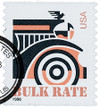
# 2906 - 1996 10c Automobile, self-adhesive coil
US#2906
1996 Automobile
- Self-Adhesive
- Issued previous year with water-activated gum
- First stamp in new series
- Non-denominated Bulk Rate stamp
Category of Stamp: Definitive
Set: American Transportation
Value: 10¢, Bulk Rate
First Day of Issue: June 15, 1996
First Day City: San Antonio, Texas
Quantity Issued: 450,000,000
Printed by: J.W. Fergusson & Sons for Stamp Venturers
Printing Method/Format: Photogravure, Coils of 10,000 from printing cylinders of 252 subjects (12 across, 21 down)
Perforations: Die cut
Reason the stamp was issued: This coil stamp was issued the third-class bulk mail rate. It was one of the first stamps issued in the new American Transportation series.
About the stamp design: The Automobile stamp pictures the front of a classic automobile, like those produced before World War II. The image was chosen from a group of concept sketches then reworked on a computer.
Special design details: The small “1995” in the bottom left corner was changed to “1996” when the stamp was reissued the following year.
First Day City: The First Day of sale took place at the Texpex in San Antonio, Texas.
About the American Transportation series: On March 10, 1995, the USPS issued the first stamps in two new definitive series – American Scenes and American Transportation (not to be confused with the Transportation Series).
These two series, as well as the American Culture Series, were created for 1995 as part of the USPS process of converting its service-inscribed stamps for discounted bulk mail to non-denominational postage. Bulk mailers could buy the appropriate stamps at a fixed price, affix them to their mail, and then pay the difference between the cost of the stamps and current postage when they mailed them out. This was done so that new stamps wouldn’t need to be created when rates changed.
During the First Day of Issue ceremonies, a representative from the Citizens’ Stamp Advisory Committee dedicated the stamps and said “It is well known that mailers, the public, and the stamp collectors like to see both a variety of designs as well as changes in designs. Starting with this rate change, each type of discount rate will have its own non-denominated stamp series. It is also planned to perhaps change the designs in each series yearly.”
The 10¢ Automobile stamp (from the American Transportation Series) was issued to fill the regular third-class rate. The USPS said this new series would “depict details of the various means of transportation in multicolor photogravure, unlike the complete vehicles in the single-color engraved Transportation Series.”
US#2906
1996 Automobile
- Self-Adhesive
- Issued previous year with water-activated gum
- First stamp in new series
- Non-denominated Bulk Rate stamp
Category of Stamp: Definitive
Set: American Transportation
Value: 10¢, Bulk Rate
First Day of Issue: June 15, 1996
First Day City: San Antonio, Texas
Quantity Issued: 450,000,000
Printed by: J.W. Fergusson & Sons for Stamp Venturers
Printing Method/Format: Photogravure, Coils of 10,000 from printing cylinders of 252 subjects (12 across, 21 down)
Perforations: Die cut
Reason the stamp was issued: This coil stamp was issued the third-class bulk mail rate. It was one of the first stamps issued in the new American Transportation series.
About the stamp design: The Automobile stamp pictures the front of a classic automobile, like those produced before World War II. The image was chosen from a group of concept sketches then reworked on a computer.
Special design details: The small “1995” in the bottom left corner was changed to “1996” when the stamp was reissued the following year.
First Day City: The First Day of sale took place at the Texpex in San Antonio, Texas.
About the American Transportation series: On March 10, 1995, the USPS issued the first stamps in two new definitive series – American Scenes and American Transportation (not to be confused with the Transportation Series).
These two series, as well as the American Culture Series, were created for 1995 as part of the USPS process of converting its service-inscribed stamps for discounted bulk mail to non-denominational postage. Bulk mailers could buy the appropriate stamps at a fixed price, affix them to their mail, and then pay the difference between the cost of the stamps and current postage when they mailed them out. This was done so that new stamps wouldn’t need to be created when rates changed.
During the First Day of Issue ceremonies, a representative from the Citizens’ Stamp Advisory Committee dedicated the stamps and said “It is well known that mailers, the public, and the stamp collectors like to see both a variety of designs as well as changes in designs. Starting with this rate change, each type of discount rate will have its own non-denominated stamp series. It is also planned to perhaps change the designs in each series yearly.”
The 10¢ Automobile stamp (from the American Transportation Series) was issued to fill the regular third-class rate. The USPS said this new series would “depict details of the various means of transportation in multicolor photogravure, unlike the complete vehicles in the single-color engraved Transportation Series.”













